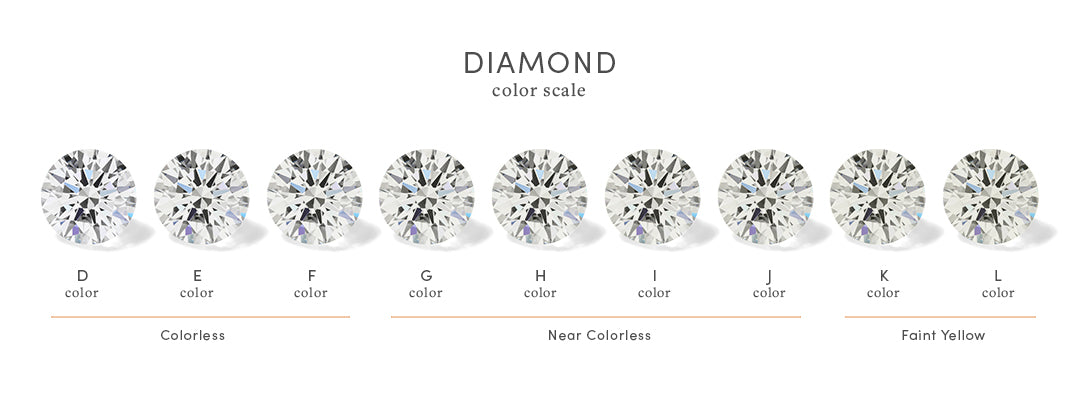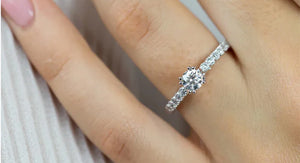The 4 C’s are the major visual attributes of a diamond. They include Carat, Cut, Color and Clarity. These 4 characteristics are graded and categorized to identify the size and quality of the diamond. They also help is differentiating between similar diamonds and establishing the diamond’s value and price. The grading scales for the 4 C’s are established by the Gemological Institute of America or GIA. The standardized grading scale practices allow consumers and gemologists to accurately identify diamonds. Once you’ve mastered the 4 C’s you’ll be ready to effectively select a diamond that works within your price range and maximize the quality and size factors within that price. This guide will effectively educated you on the basics so you know what to look for and how to evaluate a diamond and its quality/value.
Carat: The Most Visual C – Size
Diamond carat is its weight and reflects the diamond’s size. The larger the diamond, the rarer and more valuable it becomes. Carat is the most visible C. Not to be confused with karat (a measure of gold purity), a 1.00 carat or ct diamond weighs 0.20 grams. The size of a diamond is measured in millimeters by length and width or in other words the diameter of the diamond. It typically takes about 250 tons of rock mining to produce just 1.00ct of diamond. That is why diamonds are rare and expensive.
Diamonds within each carat range have average millimeter sizes so you can approximate their visual size. Although each diamond is unique, these millimeter measurements are typically the norm, especially since diamonds today are cut with machines to ensure precision. To truly understand the diamond’s size, evaluate the measurements. Well cut Round diamonds have less depth than well cut fancy shaped diamonds (diamonds other than Round).

Diamond pricing increases exponentially, not linearly, as diamond carat weight increases. Once a diamond hits it’s critical weight, the price bumps up. The critical weights are: 0.30ct, 0.40ct, 0.50ct, 0.70ct, 0.90ct 1.00ct, 1.50ct, 2.00ct, 3.00ct, 4.00ct, 5.00ct, 10.00ct. Diamond cutters will do everything they can to keep the diamond weight at or above each critical weight.
The average diamond carat weight is 0.90ct. Consumers prefer Carat above the other C’s of diamonds because carat is the most visual C. When pricing diamonds, think about carat on one side and the other 3 C’s on the other side. In order to fit your diamond budget, as you increase carat, you may need to reduce the other C’s. Vice versa, if you increase the other C’s, you may need to decrease carat.
Cut: The Diamond’s Sparkle
Diamonds are cut to maximize the sparkle, fire, brilliance and overall visual beauty of a diamond. The cut is a measure of light performance as light hits a diamond. Diamonds sparkle is a result of light performance. As light hits a diamond, it penetrates the diamond, bounces around and reflects within the diamond and ultimately returns light to your eye. That is the sparkle that you see. The cutting of a diamond directly impacts the amount of light performance achieved. The angles, locations, sizes and shapes of facets will determine the diamond sparkle.

Fair & Poor: Diamonds with significant light leakage earn a Fair or Poor grade. These diamonds tend to leak noticeable amounts of light from being too deep or shallow in height. These have little brilliance and are less visually appealing. Fair or Poor cut diamonds do not meet With Clarity’s minimum light performance criteria. This cut category represents the top 35% of gem quality diamonds. Avoid these diamonds as they will not make for sparkling jewelry.
Very Good: Very well cut diamonds that capture almost all the potential of the diamond. Very brilliant with minimal light leakage. Diamonds cut often intentional cut to achieve a Very Good grade so that can improve the other characteristics of the diamond such as Color, Clarity or Carat. The top 15% of gemstone quality diamonds are Very Good cut. Very Good cut diamonds can be a great choice if looking maximize value on the other factors.
Good: Well cut diamonds that capture light and possess high degrees of sparkle. Good cut diamonds have some light leakage, but overall shine bright. These diamonds can have noticeably larger or even smaller measurements than perfectly cut diamonds of the same shape. Cutters may intentionally cut to Good proportions to achieve a particular look or style. The top 25% of diamonds have a Good cut grade. Good cut diamonds can be a good blend of value and size, however be careful and always ask a gemologist to assess the particular diamond for you before you make a decision.
Excellent: The highest grade representing the top diamonds in the world. Diamonds with an Excellent cut grade are masterfully crafted and precisely cut to unleash the maximum sparkle and brilliance of a diamond. Little or no light leakage occurs as light passes through a diamond. This premium category represents the top 3% of all diamonds. Excellent cut diamonds are increasing with improvements in manufacturing technology. An excellent cut diamond is always a good choice regardless of diamond shape and size.
Cut is often consider the most important of the 4 C’s of diamonds (carat is more of a preference, not an art or science). When selecting a diamond, it will certainly important to ensure light is not lost. Excellent cuts are most premium and Very Good cuts offer more value. The differences in sparkle are quite subtle, but they are noticeable when compared side by side. We recommend maximizing on the Cut grade, if possible.
Color: Diamond’s Shade or Tint
A diamond’s color is the soft tint of shade of yellow/brown that is seen inside the diamond. All diamonds on the GIA D through Z scale are considered white although on the lower end they can have a tinge of yellow color. Color is a natural element in diamonds. The more yellow/brown the tint of color, the less the sparkle of the diamond because light performance/reflection is reduced. Color is essentially a visual distraction that affects sparkle. The grade is a representation of how much that color shade can be seen. Diamond color is grading by evaluating the body color of the diamond on a pure white background, face down. From face up, color is harder to identify.

Clarity: The Diamond’s Unique Imperfections
During the diamond growth process, microscopic impurities or imperfections become present within the diamond. These imperfections are known as diamond inclusions. Inclusions are extremely common within diamonds and are essentially birthmarks that give every diamond uniqueness. The inclusions cumulatively make up the diamond’s clarity. This clarity is measured by gemologists and graded on a scale. Diamonds range in clarity from FL – I3. Inclusions are examined at 10x magnification.
When evaluating the 4C’s, clarity is the third most important characteristic because most imperfections cannot be seen unless under at least 10 times magnification. ( Cut is the most important 4C to consider). To maximize your budget, consider an SI quality diamond, knowing that it may have very slight inclusions visible to the naked eye if the stone is examined very closely.
Beyond the 4C’s
When you are diamond shopping, it’s easy to get overwhelmed and focus on the big four C’s namely the color, cut, clarity, and carat.
Let’s take a moment and go beyond the 4C’s so that you find yourself informed, educated, and ready to make a decision. Looking at a diamond from all sides is not only essential but may also shed light on the symmetry of the diamond. Symmetry is the term that talks about how precisely the various facets of a diamond come together. It is a grading of how symmetrically the diamond has been cut. While discussing symmetry, there are a plethora of elements that can impact it like the facets, angles, height, angles, and girdles amongst others. While it is not necessary that all diamonds be symmetrical, a diamond with poor symmetry may be a bad thing as it reduces the diamond’s brilliance. How you may ask? Poor symmetry may misdirect light that travels into the diamond and send it off at slightly wrong angles leaving you with a diamond that cannot reflect white light well.
That’s where diamond brilliance comes into this picture. It refers to a diamond’s ability to reflect white light which means more white light, more reflection, more brilliant!
A simple formula to go by is good polish + good symmetry = great brilliance + great sparkling which in turn equals a great diamond!
Asymmetrical diamonds will thus steer you away from purchasing a piece as it shies away from a basic expectation such as their shape. Round diamonds may land up looking more ovalish in shape and while that is not necessarily a bad thing, it may not be what you are looking for. Especially when you are buying a fancy-cut diamond (like a marquise or pear-shaped stone), you are paying for the shape and would expect it to match.
Coming to the polish which takes place after a diamond is cut, haven’t we all marveled at a diamond cutter’s job after he lends the finishing to the stone to achieve a smooth surface? Just so that you are left with a flawless piece that you can sparkle with. Better the polish, higher the ranking of the stone, and of course, more expensive the piece (because polish could make or break any signs of an imperfection the cutter may have missed). Some polishing marks are so faint that they cannot be seen with the naked eye. While all diamonds will have a flaw (however minute) like a scratch, abrasion, rough girdle, or a nick due to polish, they can be found only with high magnification.
Another crucial factor is the diamond depth which refers to its height (in millimeters) measured from the culet (bottom tip) to the table (flat top surface). The depth is expressed as a percentage – divide the diamond’s total height by its total width and you have yourself a number which you can find on the diamond’s certification (as you will the above parameters). So, the deeper the diamond’s depth, the higher the diamond’s depth percentage. With the right proportion, you have found yourself a stronger and more beautiful sparkle. A shallow depth will impact the sparkle and fire as will a deep diamond which may look thinner and thus smaller. There is no ideal depth (ranging from poor to excellent) for a diamond so keep in mind that the ideal depth range will depend on the cut you will choose.
While on this topic, you should also know about diamond fluorescence which is the glow you sometimes see when an object emits light that you can see. Once the light source (like the sun or fluorescent lamp) is taken away, the fluorescence also goes away. It is really as simple as that and may or may not be seen by the naked eye. About 30% of diamonds exhibit some level of fluorescence and are considered an important identifying characteristic, not a defining one. While it is not a grading factor, a diamond’s fluorescence is identified and recorded by its intensity – None, faint, medium, strong, or very strong. Fluorescence is neither good nor bad and it depends on what you see, what you like, and what you are looking for in your piece. In some cases though, any presence of fluorescence in a diamond may bring down its value to an extent.


1 Comment
[…] An official IGI certification for diamonds is a detailed testament to a specific diamonds authenticity. It isn’t something that a diamond professional can just look at a diamond and properly issue. It takes lots of time, patience, various pieces of equipment and comparisons to other diamonds thought to be in the same certification category to accurately and justifiably assign diamonds an IGI certification. Before a diamond truly qualifies for such certification, it must meet certain high-priority standards, even among the higher-quality diamonds, and must be analyzed for the flawlessness of its characteristics, including (but not limited to) the 4 C’s: carat, color, clarity and cut. […]